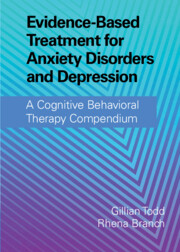 Evidence-Based Treatment for Anxiety Disorders and Depression
Evidence-Based Treatment for Anxiety Disorders and Depression Book contents
- Evidence-Based Treatment for Anxiety Disorders and Depression
- Evidence-Based Treatment for Anxiety Disorders and Depression
- Copyright page
- Contents
- Figures
- Tables
- Contributors
- 1 Introduction
- 2 The History and Philosophical Underpinnings of CBT:
- Part One Cognitive Behavioral Therapy for Anxiety Disorders
- Part Two Cognitive Behavioral Therapy for Posttraumatic Stress Disorder
- Part Three Cognitive Behavioral Therapy for Obsessive-Compulsive Disorder and Associated Disorders
- 11 Obsessive-Compulsive Disorder:
- 12 CBT for OCD:
- 13 Obsessive Compulsive Disorder:
- 14 Other Specified and Unspecified Obsessive-Compulsive and Related Disorders
- 15 A Cognitive Behavioral Approach to Body Dysmorphic Disorder:
- 16 Comprehensive Behavioral Treatment for Trichotillomania (Hair Pulling Disorder) and Excoriation (Skin Picking) Disorder
- 17 Cognitive Behavioral Therapy for Hoarding Disorder
- Part Four Cognitive Behavioral Therapy for Depression
- Part Five Complexity and Comorbidity in Anxiety Disorders and Depression:
- Part Six Specialist Applications of Cognitive Behavioral Therapy for Anxiety Disorders and Depression
- Part Seven Future Developments
- Appendices
- Index
- References
15 - A Cognitive Behavioral Approach to Body Dysmorphic Disorder:
Assessment, Treatment, and New Developments
from Part Three - Cognitive Behavioral Therapy for Obsessive-Compulsive Disorder and Associated Disorders
Published online by Cambridge University Press: 06 January 2022
- Evidence-Based Treatment for Anxiety Disorders and Depression
- Evidence-Based Treatment for Anxiety Disorders and Depression
- Copyright page
- Contents
- Figures
- Tables
- Contributors
- 1 Introduction
- 2 The History and Philosophical Underpinnings of CBT:
- Part One Cognitive Behavioral Therapy for Anxiety Disorders
- Part Two Cognitive Behavioral Therapy for Posttraumatic Stress Disorder
- Part Three Cognitive Behavioral Therapy for Obsessive-Compulsive Disorder and Associated Disorders
- 11 Obsessive-Compulsive Disorder:
- 12 CBT for OCD:
- 13 Obsessive Compulsive Disorder:
- 14 Other Specified and Unspecified Obsessive-Compulsive and Related Disorders
- 15 A Cognitive Behavioral Approach to Body Dysmorphic Disorder:
- 16 Comprehensive Behavioral Treatment for Trichotillomania (Hair Pulling Disorder) and Excoriation (Skin Picking) Disorder
- 17 Cognitive Behavioral Therapy for Hoarding Disorder
- Part Four Cognitive Behavioral Therapy for Depression
- Part Five Complexity and Comorbidity in Anxiety Disorders and Depression:
- Part Six Specialist Applications of Cognitive Behavioral Therapy for Anxiety Disorders and Depression
- Part Seven Future Developments
- Appendices
- Index
- References
Summary
Cognitive behavior therapy (CBT) is the treatment of choice for people with body dysmorphic disorder (BDD). The first part of the chapter describes the clinical features and processes of BDD, and introduces an updated CBT model of the self as an aesthetic object that evolves around the notion that people with BDD experience distressing mental imagery of their disliked features, maintained by self-focused attention and safety-seeking behaviors. In the second part of the chapter, we present an updated assessment and treatment protocol to BDD. We use case material to illustrate how to engage clients and socialize them into a psychological way of working to overcome their appearance concerns. We illustrate assessment and formulation, how to set up effective behavioral experiments, how to conduct mirror retraining, imagery rescripting, and compassion-focused techniques. BDD screening and diagnostic measures are also presented.
Keywords
- Type
- Chapter
- Information
- Evidence-Based Treatment for Anxiety Disorders and DepressionA Cognitive Behavioral Therapy Compendium, pp. 295 - 315Publisher: Cambridge University PressPrint publication year: 2022


